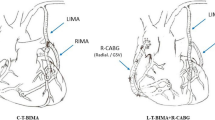Summary.
Objective: CABG with bilateral IMA grafts (BIMA) can improve long-term results in cardiac morbidity and mortality. An enhanced incidence of bleeding and wound complications compared to patients with single IMA (SIMA) remains a matter of debate. The aim of the study was to compare the operative outcomes of patients who had undergone CABG with BIMA and SIMA in situ grafts, especially to identify patient-related risk factors, such as obesity, diabetes mellitus and age above 70 years. Methods: Out of a total of 5144 patients operated on between January 1996 and September 1999, patients with isolated CABG (n=3671) with BIMA or SIMA were analyzed retrospectively. In the BIMA group, the patients’ (n=1478) mean age was 64.0 years; mean EF was 62.1%. In the SIMA group (n=2184), mean age was 65.4 years and mean EF was 60.6% (n.s.). In the BIMA group, the right IMA was led anterior of the aorta to the LAD, the left IMA to the lateral wall. In the SIMA group, the LAD was revascularized with the left IMA. Additional bypasses were perormed with vein grafts. Results: The 30-day mortality was 1.6% in the BIMA group, 1.7% in the SIMA group in patients under 70 years, and 4.1% (BIMA) and 4.0% (SIMA) in patients over 70 years (p=n.s.). A significantly higher blood loss was observed in the BIMA group (BIMA 979±708ml; SIMA 790±575ml; p<0.05). The rethoracotomy rate due to bleeding was significantly higher in patients with BIMA (4.1%) compared to those with SIMA (2.5%; p<0.05). In patients with a body mass index (BMI) of less than 27, no significant difference could be found (SIMA 2.8%, BIMA 3.4%; p=n.s.). Patients with a BMI>27 showed a significantly higher rethoracotomy rate (SIMA 2.2%; BIMA 4.9%). A higher incidence of sternal instabilities could be observed in the BIMA group (4.2%; p<0.05). Diabetes mellitus could not be identified as an independent risk factor for sternal complications (SIMA 2.9%; BIMA 5.0%; p=n.s.). Conclusion: CABG using both IMAs can be performed in nearly all patients as a routine method with good clinical results and low mortality. Bleeding in the BIMA group within 48h was increased. BMI>27 could be identified as a risk factor for sternal complications, but not diabetes mellitus or age over 70years.
Zusammenfassung.
Hintergrund: Durch die Verwendung beider Arteriae mammariae internae (IMA) zur Myokardrevaskularisation können die Langzeitergebnisse hinsichtlich kardialer Morbidität und Mortalität verbessert werden. Eine erhöhte Inzidenz an Blutungs- und Wundkomplikationen im Vergleich zu Patienten mit unilateralem IMA-Bypass bleibt ein Diskussionspunkt. Ziel der vorliegenden Untersuchungsreihe ist es, die operativen Ergebnisse von Patienten mit aortokoronarer Bypassoperation (ACB) mit bilateralem in situ Arteria mammaria interna Bypass (BIMA) und mit einfachem (single) in situ Arteria mammaria interna Bypass (SIMA) zu vergleichen, insbesondere patientenspezifische Risikofaktoren, wie Adipositas (BMI=body mass index ≥27), Diabetes mellitus und fortgeschrittenes Alter über 70 Jahre, zu identifizieren. Patienten und Methodik: Von insgesamt 5144 zwischen Januar 1996 und September 1999 operierten Patienten analysierten wir retrospektiv die Daten von Patienten mit isolierter ACB (n=3671) mit BIMA oder SIMA. In der BIMA-Gruppe (n=1487) betrugen das mittlere Alter der Patienten 64,0 Jahre und die mittlere Ejektionsfraktion (EF) 62,1%. In der SIMA-Gruppe (n=2184) betrugen das mittlere Alter 65,4 Jahre und die mittlere EF 60,6% (p=n.s.). In der BIMA-Gruppe wurde die rechte IMA anterior der Aorta ascendens mit der LAD anastomosiert, die linke IMA mit einem Gefäß der linkslateralen Seiten- oder Hinterwand. In der SIMA-Gruppe wurde die LAD mit der linken IMA revaskularisiert. Zusätzliche Bypässe wurden mit Venentransplantaten angefertigt. Ergebnisse: Die 30-Tage-Mortalität betrug 1,6% in der BIMA-Gruppe, 1,7% in der SIMA-Gruppe bei Patienten unter 70 Jahren, und 4,1% (BIMA) und 4,0% (SIMA) bei Patienten über 70 Jahren (p=n.s.). Ein signifikant höherer Blutverlust wurde in der BIMA-Gruppe beobachtet (BIMA 979±708ml; SIMA 790±575ml; p<0,05). Die Rethorakotomierate wegen Blutung war signifikant höher bei Patienten mit BIMA (4,1%) verglichen mit denen mit SIMA (2,5%; p<0,05). Bei Patienten mit BMI<27 konnte kein signifikanter Unterschied entdeckt werden (SIMA 2,8%; BIMA 3,4%; p=n.s.). Patienten mit BMI>27 zeigten eine signifikant erhöhte Rethorakotomierate (SIMA 2,2%; BIMA 4,9%; p<0,05). Eine erhöhte Inzidenz an Sternuminstabilitäten wurde in der BIMA-Gruppe beobachtet (4,2%; p<0,05). Diabetes mellitus konnte nicht als unabhängiger Risikofaktor für Sternuminstabilitäten identifiziert werden (SIMA 2,9%; BIMA 5,0%; p=n.s.). Schlussfolgerung: Der bilaterale IMA-Bypass kann bei fast allen Patienten als Standardvorgehen mit guten klinischen Ergebnissen und niedriger Mortalität durchgeführt werden. Die Blutungsrate in der BIMA-Gruppe innerhalb 48h war erhöht. BMI>27 konnte als Risikofaktor für sternale Komplikationen identifiziert werden, jedoch nicht Diabetes mellitus oder Alter über 70 Jahre.
Similar content being viewed by others
Author information
Authors and Affiliations
Additional information
This article has been retracted as it represents a substantial duplication of the article: B. Gansera, R. Günzinger, I. Angelis, W. Eichinger, P. Neumaier, M. Breuer, and B.M. Kemkes: End of the Millenium – End of the Single Thoracic Artery Graft? Two Thoracic Arteries – Standard for the Next Millenium? Thorac Cardiov Surg (2001) 49:10-15
Eingegangen: 18. September 2002 Akzeptiert: 27. Januar 2003
Correspondence to Brigitte Gansera
Ein Erratum zu diesem Beitrag ist unter http://dx.doi.org/10.1007/s00392-012-0525-2 zu finden.
Rights and permissions
About this article
Cite this article
Gansera, B., Angelis, I., Botzenhardt, F. et al. ZURÜCKGEZOGEN: Ende eines Jahrtausends – Ende des Einfach-Mammaria-Bypasses. Zwei Arteriae mammariae internae – Standard für das nächste Jahrtausend? . Z Kardiol 92, 398–406 (2003). https://doi.org/10.1007/s00392-003-0926-3
Published:
Issue Date:
DOI: https://doi.org/10.1007/s00392-003-0926-3




